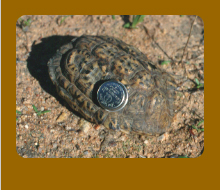
 |
|
Research on tortoises: Why should you sponsor it? Tortoises and their survival strategies Tortoises belong to the oldest animal groups and have existed in their present form since the dinosaurs still ruled the world. Their unique and diverse survival strategies have served them well through the millions of years, despite continually changing environmental conditions. Notable characteristics of the tortoise life history strategy include attaining great longevity, together with low reproduction rate throughout the long lifespan. The latter begins at sexual maturity, which is reached at a relatively late age. The influence of mankind When mankind arrived on the evolutionary scene, the survival strategies of the tortoises were not able to protect these reptiles from the new threats. Mankind is eliminating tortoise populations by:
The role of tortoises in the ecosystem In common with every other organism, tortoises play a role in their ecosystem. Eliminating one species means that its role will no longer be carried out and this can bring about unpredictable consequences. Some plants are dependent on animals (mainly insects) for their sexual reproduction. Elimination of these insects very often leads to the extinction of these plant species, which in turn can lead to other changes. The ecological roles of tortoises in the ecosystem have been largely unstudied. It is known that diverse tortoise species consume seeds and in this way, they may contribute to the distribution of the parent species. Research is urgently needed to predict what the consequences for the ecosystem would be if these tortoise species should become extinct. Some tortoises existed at such high densities that it seems highly unlikely that they played an unimportant role in ecosystem functioning. Given that the slow growth and low reproductive output of tortoises makes them vulnerable, many land tortoises are considered to be sentinel species. By this it is meant that if there is an impact on a given ecosystem, the first population to register this negative effect is likely to be that of a tortoise species. South African tortoises South Africa has the greatest number of tortoise species on the planet. Although South Africa has a tradition of nature protection and conservation generally, the native tortoise species still experience various survival threats. The suitable habitats for many species are being reduced because of growing human populations. This results in wilderness areas being brought under agriculture, dead tortoises are frequently found on roads, overgrazing is a problem, and in some places, mining activities also threaten suitable tortoise habitat. The tortoise genera Chersobius and Homopus occur almost exclusively in South Africa. The species in these genera occur in relatively small geographic areas. The tortoises are small and are highly specialised for survival in a specific type of environment. This makes them sensitive species for many environmental and other disturbances. Dwarf Tortoise Conservation Dwarf Tortoise Conservation was founded with the intention of preventing the long-term extinction of the Chersobius and Homopus tortoises. This scientific-based foundation has a mission to gather and distribute data on these animals in such a way that the future survival of these tortoises is supported. The basic guiding principle is that a species cannot be effectively protected if there is nothing known about its life history. In this way, the mission of the foundation is spearheaded by the drive to perform scientific ecologically-based research in the natural range of these tortoises. Only with such detailed information can effective protective measures be developed that are compatible with the growth in the South African human population, and that will allow the continued existence of Chersobius and Homopus tortoises. Ex situ protection In general, nature conservation organisations concentrate themselves primarily on the protection of species in the natural range and carry out most of their activities there (in situ approach). In some instances, it is also justifiable to keep populations of a species outside of its natural range (ex situ approach). This facilitates more intensive study under controlled conditions and is often a more efficient and faster manner to generate basic data to compliment field studies. Many zoos work almost exclusively with the ex situ approach. Dwarf Tortoise Conservation is one of the few organisations that is actively working both in situ and ex situ. Expenses The research of Dwarf Tortoise Conservation is carried out wholly by dedicated and well educated volunteers. The supervision is by academic biologists, also on a voluntary basis. This means that 100% of all donations is available for research materials. There are few other organisations that can ensure that donated funds are used in such a financially efficient manner. A financial overview is produced annually where all income and expenditure is accounted for. Collaborations Dwarf Tortoise Conservation collaborates closely with the University of the Western Cape, the Northern Cape Department of Environment and Nature Conservation, CapeNature, and the European Studbook Foundation. Furthermore, on an ad hoc basis the foundation collaborates with and has links to several other universities and institutions. What is Dwarf Tortoise Conservation? Dwarf Tortoise Conservation is a scientific-based foundation with a mission to gather and distribute data on the tortoises of the genera Chersobius and Homopus in such a way that the future survival of these tortoises is supported. The foundation achieves this by:
In short Tortoise research is important because tortoises:
Dwarf Tortoise Conservation info@dwarftortoises.org Donations? Dwarf Tortoise Conservation, IJsselstein IBAN bank account NL92TRIO0198330111 BIC/SWIFT address bank: TRIONL2U Triodos Bank NV, Zeist, Netherlands Registration number with the Chamber of Commerce 30170493 Top |